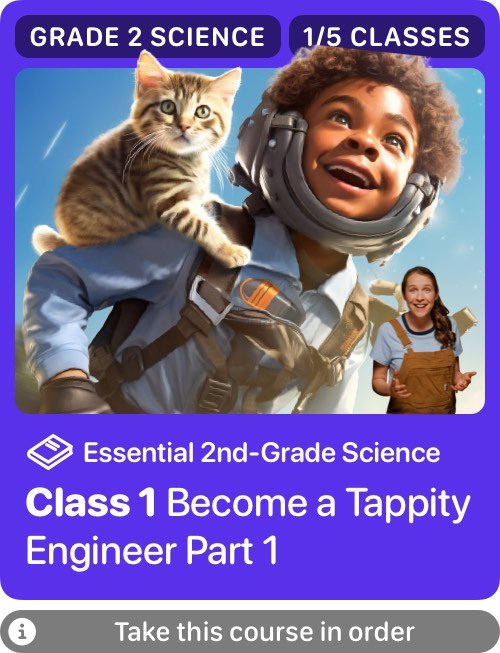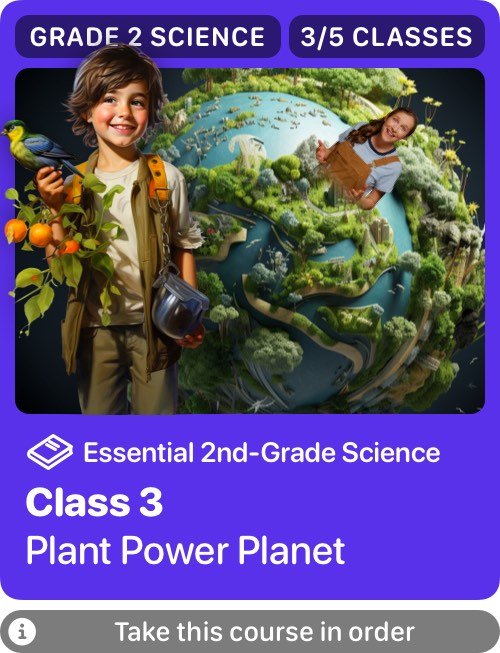Course Schedule
Course Description
In this course, students cover the most important and complex science concepts for 2nd graders. Each class builds on the skills learned in the previous class so kids develop a deeper understanding of challenging science topics and how to apply them in the real world. The first two classes are focused on learning how to think like an engineer/scientist, properties of materials, and states of matter. In the next two classes, students will apply their new skills to studying the world of plants and geology, where they will need to solve real-world problems like an engineer. This course is typically completed in 6-10 weeks.
Meet The Instructor
Meet Haley, the superhero of science education! With her superpower of making tough ideas simple, she's captivated young minds for over a decade. And Haley isn't just a teacher - she's a star and producer of thousands of thrilling science videos that have been viewed over 40 million times globally! With a knack for making learning a wild ride, Haley lights the spark of curiosity in every young scientist.
Our Core Goals For Science Education
We have three high-level goals with every science course we teach: increase motivation/excitement to learn, teach practical skills, and prepare the student academically.
-
Motivational goal: Spark a natural curiosity for the world so that learning is more about the journey than the destination.
Practical goal: Help students think logically and formulate well-structured questions about the world so they can find the answer to any question they come up with (even if the answer is “we don’t know yet”).
Academic goal: Cover the most important NGSS standards to give students confidence and set them up for any future academic endeavor they wish to pursue.
Skills Next Generation Science Standards & Covered
-
The Next Generation Science Standards are the most well-developed science standards for K-12 globally. They aren’t perfect (no one-size-fits-all standards are), but they are a great starting point. We combine these standards with what children are curious about, current world events, and practical skills to provide a well-rounded science curriculum that prepares children for anything they might want to pursue. Below is a description of the academic standards we use as a starting point for this course.
-
2-PS1-1. Plan and conduct an investigation to describe and classify different kinds of materials by their observable properties.
2-PS1-2. Analyze data obtained from testing different materials to determine which materials have the properties that are best suited for an intended purpose.* [Clarification Statement: Examples of properties could include, strength, flexibility, hardness, texture, and absorbency.] [Assessment Boundary: Assessment of quantitative measurements is limited to length.]
One interesting property of materials is whether they are an insulator (a material that does not allow the movement of heat) or a conductor (a material that moves heat easily). If you know which property a material has, you can choose the best one for your purpose!
-
2-PS1-4. Construct an argument with evidence that some changes caused by heating or cooling can be reversed and some cannot. [Clarification Statement: Examples of reversible changes could include materials such as water and butter at different temperatures. Examples of irreversible changes could include cooking an egg, freezing a plant leaf, and heating paper.]
Cause and Effect
Events have causes that generate observable patterns.
In class example: Another thing we can learn about materials is whether they can melt or not. When a material is meltable, it turns into a liquid when we heat it up. Different meltable materials melt at different temperatures. Some may even melt in your hands, while others require heat like fire. This property is cool because we can melt a substance, pour it into a mold, let it cool and harden, and then we have a new shape!
-
K-2-ETS1-1. Ask questions, make observations, and gather information about a situation people want to change to define a simple problem that can be solved through the development of a new or improved object or tool.
K-2-ETS1-2. Develop a simple sketch, drawing, or physical model to illustrate how the shape of an object helps it function as needed to solve a given problem.
K-2-ETS1-3. Analyze data from tests of two objects designed to solve the same problem to compare the strengths and weaknesses of how each performs.
-
2-ESS2-2. Develop a model to represent the shapes and kinds of land and bodies of water in an area.
2-ESS2-3. Obtain information to identify where water is found on Earth and that it can be solid or liquid.
How to book & structure this course
In this course, it's important to follow the order of classes as they build on each other and help your child understand the concepts step by step. Once they've completed most of the after-class problems and hands-on activities, they can move on to the next class. Remember, skipping activities that may not work for your family or situation is perfectly fine.
Classes in this course
Class 1: Become a Tappity Engineer Part 1
In this class, students begin their Essential 2nd Grade Science journey and learn to think like an engineer! This class equips kids with the skills to solve real-world science problems like a scientist/engineer. These skills will be applied throughout the course.
Class 2: Become a Tappity Engineer Part 2
In this class, students complete their introduction to thinking like an engineer. Students will continue to learn new properties of materials and decide how these characteristics might help solve problems. In class, they will invent their own material, describe its properties, and explain why it is uniquely capable of solving a problem.
What To Bring To Class
You will need ~20 index card for this class (you can also cut up regular paper instead)
Class 3: Plant Power Plant
In this class, students will study plants and seeds from the perspective of an engineer in order to unravel the mystery behind their unique characteristics. We'll run an experiment to discover how the same tree species can end up on two distant islands and how seeds have adapted for optimal dispersal. Get ready to be inspired by the ingenious structures and designs of the natural world, and learn how they can spark innovative engineering ideas!
How did a tree travel halfway around the world? Why are some seeds so big? Why does fruit exist?
Class 4: The Power of Water + Time
In this class, students delve into the world of erosion to learn how various land formations are created. Through two hands-on experiments, they discover how water shapes canyons and apply their engineering knowledge from earlier in the course to develop ways to prevent landslides, just as real scientists do. This class takes a deep dive into the power of water and the materials used to mitigate natural disasters.
How do canyons form? How could we prevent a landslide? Why do wildfires make it more likely for landslides to occur? Where to rivers lead?
Class 5: 2nd-Grade Science Trivia
Welcome to the grand finale of our science course! The trivia class is a dynamic gameshow-style class designed to be taken multiple times. With each session featuring new and challenging questions, students get to apply the knowledge they learned throughout the course to both familiar and challenging questions. It's the perfect opportunity to showcase understanding and have fun with your fellow 2nd-grade scientists!
Course Pricing & Packages
Have questions? Hit the chat button in the bottom right corner and ask away!
Schedule This Course
Below are the class times for each class in this course. Schedule all/part of the course ahead of time or schedule it on the fly.










